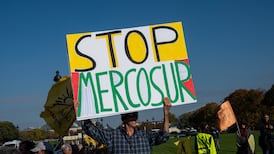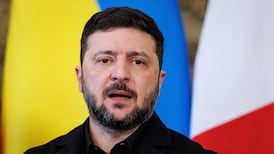On January 19th, in the southern town of Aguilar de la Frontera, a workman with an electric saw cut into the base of a tall stone cross outside a convent. Once he had sawn through it, the cross was taken down and driven away in a truck.
It was just one of dozens of statues, monuments and street names that have been removed from public view in Spain in recent years as part of an effort to purge the country of symbols of the dictatorship of Francisco Franco.
But while that broader historical memory campaign has long been divisive, a recent focus on removing Catholic religious symbols because of their associations has been particularly controversial.
The cross in Aguilar de la Frontera was originally erected as a tribute to the troops who died fighting under the orders of Franco, who led an insurrection against the leftist republican government, triggering the 1936-39 civil war. The general emerged victorious from that conflict before leading a dictatorship for the next four decades.
The leftist mayor of the town, Carmen Flores, who was not available to comment for this article, announced the removal of the cross “because of its connotations” and she cited a recent historical memory law. Although a plaque dedicating the cross to Franco’s troops was removed in 1981, Flores and others are adamant that the monument was tainted.
‘Fascist symbol’
“Its origins are as a fascist symbol, however much you remove or replace the plaques that decorate it,” said Cecilio Gordillo, an activist in the organisation Recovering the Memory of the Social History of Andalucía. “And given that it is a symbol of hatred, an apology for a coup d’état, the church should be the first one to distance itself from Francoism.”
While the removal of the cross satisfies historical memory campaigners, it has outraged others.
“It’s a very sad day for a lot of people in Aguilar because an emblem of cultural life has been destroyed,” said José Cabezas, president of a local Catholic association that stages Easter processions. “As Christians this causes us great pain.”
These kinds of monuments are often referred to as “crosses of the fallen”, with the “fallen” being those who fought for Franco.
The most notorious example is the 150m tall stone cross at the Valley of the Fallen, a massive basilica-mausoleum in the mountains north of Madrid built by the dictator. In 2019, the body of Franco, who was buried there in 1975, was moved to a private cemetery, with the government of Socialist Pedro Sánchez arguing that the remains of a dictator should not rest at a site that glorifies his legacy.
Sánchez's leftist coalition government has said that the fate of the Valley of the Fallen cross is under consideration
Present-day Franco supporters often claim that technically the cross at the Valley of the Fallen is dedicated to the dead on both sides of the civil war. But many, particularly on the left, reject this argument and underline the overtly Francoist – and fascist – nature of the mausoleum. The Irish Hispanist Ian Gibson called the Valley of the Fallen's cross "an insult to Jesus Christ" that he would like to see knocked down.
Bitter division
The removal of Franco’s body from the Valley of the Fallen followed years of bitter division over historical memory. Many, particularly on the left, have felt that Spain has not done enough to acknowledge or investigate the human rights crimes of the Franco years; the political right tends to see the issue as a distraction from more important matters and an excuse by the left to dig up longstanding grievances.
Sánchez’s leftist coalition government has said that the fate of the Valley of the Fallen cross is under consideration. But although it has not expressed an opinion on the Aguilar de la Frontera case, it does seem to approve in general of the removal of so-called “crosses of the fallen”. The government has called on local authorities in the western region of Extremadura, for example, to remove one in the city of Cáceres on the grounds that it “contributes to perpetuating the memory of hatred and confrontation between Spaniards”.
Those who oppose such action insist that these historical links are so far in the past as to be barely relevant.
“The vast majority of people didn’t know that the cross had any kind of political connotation,” said José Cabezas, of Aguilar de la Frontera, who warned that its removal from his town has “pitted locals against each other”.
Like the United States, the political climate in Spain is particularly vitriolic at the moment. With its dictatorship – and for some its civil conflict – still within living memory, the country’s culture war has an edge to it which the religious element of this debate is sharpening further.
‘Brutal crimes’
"Hatred of Christianity has led the Spanish left to carry out brutal crimes in the past," tweeted Hermann Tertsch, a Spanish MEP for the far-right Vox, in response to the removal of the Aguilar de la Frontera cross. "Without a doubt some of them want to repeat those crimes."
Even the bishop of the southern city of Córdoba, Demetrio Fernández, has waded into the issue. “Religious feelings are there, that’s why nobody messes with them,” he said in a recent Mass, in reference to the same controversy.
“But if anyone does mess with them, they should be careful of the consequences,” he added. “We Christians are not violent, but we do pay attention ...The response will come in due time.”












